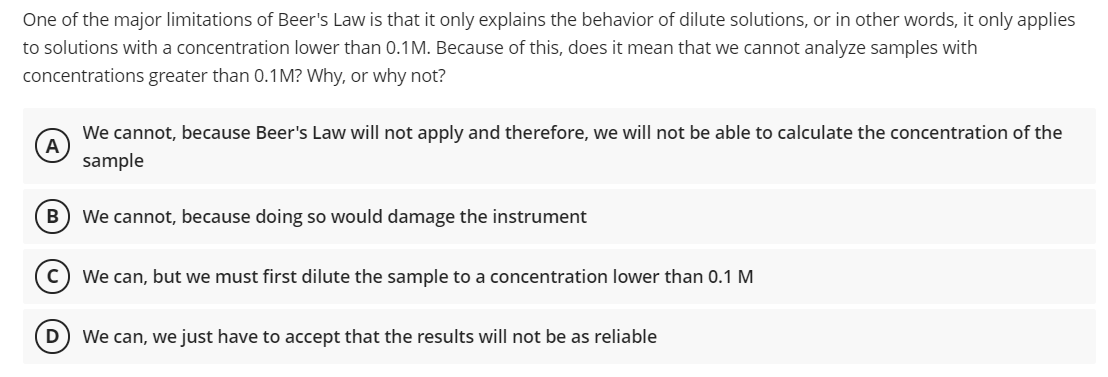One of the major limitations of Beer's Law is that it only explains the behavior of dilute solutions, or in other words, it only applies to solutions with a concentration lower than 0.1M. Because of this, does it mean that we cannot analyze samples with concentrations greater than 0.1M? Why, or why not? We cannot, because Beer's Law will not apply and therefore, we will not be able to calculate the concentration of the A sample B) We cannot, because doing so would damage the instrument We can, but we must first dilute the sample to a concentration lower than 0.1 M We can, we just have to accept that the results will not be as reliable
One of the major limitations of Beer's Law is that it only explains the behavior of dilute solutions, or in other words, it only applies to solutions with a concentration lower than 0.1M. Because of this, does it mean that we cannot analyze samples with concentrations greater than 0.1M? Why, or why not? We cannot, because Beer's Law will not apply and therefore, we will not be able to calculate the concentration of the A sample B) We cannot, because doing so would damage the instrument We can, but we must first dilute the sample to a concentration lower than 0.1 M We can, we just have to accept that the results will not be as reliable
Chemistry: Principles and Reactions
8th Edition
ISBN:9781305079373
Author:William L. Masterton, Cecile N. Hurley
Publisher:William L. Masterton, Cecile N. Hurley
Chapter10: Solutions
Section: Chapter Questions
Problem 27QAP: The Henry's law constant for the solubility of helium gas in water is 3.8104M/atm at 25C. (a)...
Related questions
Question

Transcribed Image Text:One of the major limitations of Beer's Law is that it only explains the behavior of dilute solutions, or in other words, it only applies
to solutions with a concentration lower than 0.1M. Because of this, does it mean that we cannot analyze samples with
concentrations greater than 0.1M? Why, or why not?
We cannot, because Beer's Law will not apply and therefore, we will not be able to calculate the concentration of the
A
sample
B
We cannot, because doing so would damage the instrument
We can, but we must first dilute the sample to a concentration lower than 0.1 M
We can, we just have to accept that the results will not be as reliable
Expert Solution
This question has been solved!
Explore an expertly crafted, step-by-step solution for a thorough understanding of key concepts.
This is a popular solution!
Trending now
This is a popular solution!
Step by step
Solved in 2 steps

Knowledge Booster
Learn more about
Need a deep-dive on the concept behind this application? Look no further. Learn more about this topic, chemistry and related others by exploring similar questions and additional content below.Recommended textbooks for you

Chemistry: Principles and Reactions
Chemistry
ISBN:
9781305079373
Author:
William L. Masterton, Cecile N. Hurley
Publisher:
Cengage Learning

General Chemistry - Standalone book (MindTap Cour…
Chemistry
ISBN:
9781305580343
Author:
Steven D. Gammon, Ebbing, Darrell Ebbing, Steven D., Darrell; Gammon, Darrell Ebbing; Steven D. Gammon, Darrell D.; Gammon, Ebbing; Steven D. Gammon; Darrell
Publisher:
Cengage Learning


Chemistry: Principles and Reactions
Chemistry
ISBN:
9781305079373
Author:
William L. Masterton, Cecile N. Hurley
Publisher:
Cengage Learning

General Chemistry - Standalone book (MindTap Cour…
Chemistry
ISBN:
9781305580343
Author:
Steven D. Gammon, Ebbing, Darrell Ebbing, Steven D., Darrell; Gammon, Darrell Ebbing; Steven D. Gammon, Darrell D.; Gammon, Ebbing; Steven D. Gammon; Darrell
Publisher:
Cengage Learning


Principles of Modern Chemistry
Chemistry
ISBN:
9781305079113
Author:
David W. Oxtoby, H. Pat Gillis, Laurie J. Butler
Publisher:
Cengage Learning

Chemistry: The Molecular Science
Chemistry
ISBN:
9781285199047
Author:
John W. Moore, Conrad L. Stanitski
Publisher:
Cengage Learning

Chemistry: Principles and Practice
Chemistry
ISBN:
9780534420123
Author:
Daniel L. Reger, Scott R. Goode, David W. Ball, Edward Mercer
Publisher:
Cengage Learning